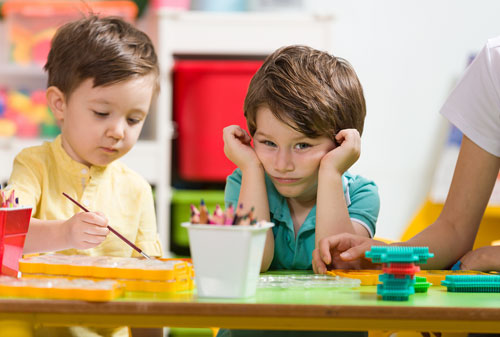




Play is an important part of the development of children and young people. Through play, children and young people develop a variety of skills supporting holistic development e.g. social, emotional, creative, intellectual, language, problem solving, physical. Play is important to children and young people’s well-being as it has an important role in building self-image, self-esteem and confidence and encourages self-expression.
Through play, children build and develop relationships with others that are important to their social development and well-being. During play, children are able to mix with children of different ages and backgrounds, developing social skills and respect for diversity. Play enables children to build resilience through risk taking and challenges as they deal with different situations. Play gives children the opportunity to relax and develop ideas without the pressure of formal learning. Physical skills and coordination are developed through play activities, such as running and climbing, and in turn support both physical health and confidence.
Play increases brain development and growth by establishing new neural connections and play is more frequent during periods of brain growth. Play stimulates production of a protein, ‘brain-derived neurotrophic factor’. This is produced in the amygdala and the prefrontal cortex, which are responsible for organising, monitoring, and planning.
It is important that children and young people learn that play is important throughout life and is essential to physical and mental well-being. If children are not given opportunities to play, they suffer from ‘play deprivation’ where they are deprived of experiences that are central to development and can be both biologically and socially disabled. Children who do not have the opportunity to play are at an increased risk of showing unwanted behaviour and abnormal development.
Children’s play is a human right. Article 31 of the United Nations Rights of the Child refers to the right of children to play.
The right to play is a child’s first claim on the community. Play is nature’s training for life. No community can infringe that right without doing deep and enduring harm to the minds and beliefs of its citizens.
Play encompasses children’s behaviour which is freely chosen, personally directed and intrinsically motivated. It is performed for no external goal or reward and is a fundamental and integral part of healthy development – not only for individual children, but also for the society in which they live.
The Welsh Government’s Play policy states:
Play is so critically important to all children in the development of their physical, social, mental, emotional and creative skills that society should seek every opportunity to support it and create an environment that fosters it. Decision making at all levels of government should include a consideration of the impact of those decisions, on children’s opportunities to play. -The Welsh Government’s Play policy
The 7 aims for children in Wales has as aim 4 ‘All children and young people have access to play, leisure, sporting and cultural activities’.
Mae chwarae'n rhan bwysig o ddatblygiad plant a phobl ifanc. Drwy chwarae, bydd plant a phobl ifanc yn meithrin amrywiaeth o sgiliau sy'n cefnogi datblygiad cyfannol, e.e. sgiliau cymdeithasol, emosiynol, creadigol, deallusol, iaith, datrys problemau a chorfforol. Mae chwarae'n bwysig i lesiant plant a phobl ifanc am fod ganddo rôl bwysig wrth ddatblygu hunanddelwedd, hunan-barch a hyder, ac am ei fod yn annog hunanfynegiant.
Drwy chwarae, bydd plant yn ffurfio ac yn meithrin perthnasoedd ag eraill sy'n bwysig i'w datblygiad cymdeithasol a'u llesiant. Wrth chwarae, gall plant gymysgu â phlant o wahanol oedrannau a chefndiroedd, gan feithrin sgiliau cymdeithasol a pharch at amrywiaeth. Mae chwarae'n galluogi plant i feithrin gwydnwch drwy gymryd risgiau ac wynebu heriau wrth iddynt ddelio â gwahanol sefyllfaoedd. Mae chwarae'n rhoi cyfle i blant ymlacio a datblygu syniadau heb y pwysau sy'n gysylltiedig â dysgu ffurfiol. Caiff sgiliau corfforol a chydsymud eu meithrin drwy weithgareddau chwarae, fel rhedeg a dringo, ac, yn eu tro, bydd yn cefnogi iechyd corfforol a hyder.
Mae chwarae'n cynyddu datblygiad a thwf yr ymennydd drwy sefydlu cysylltiadau niwral newydd, ac mae chwarae'n digwydd yn amlach yn ystod cyfnodau pan fydd yr ymennydd yn tyfu. Mae chwarae'n ysgogi'r corff i gynhyrchu protein o'r enw ‘ffactor niwrotroffig sy'n deillio o'r ymennydd’. Caiff y protein hwn ei gynhyrchu yn yr amygdala a'r cortecs cyndalcennol, sy'n gyfrifol am drefnu, monitro a chynllunio.
Mae'n bwysig bod plant a phobl ifanc yn dysgu bod chwarae'n bwysig trwy gydol eu hoes, ac mae'n hanfodol i lesiant corfforol a meddyliol. Os na chaiff plant gyfleoedd i chwarae, byddant yn dioddef o ‘amddifadedd chwarae’ lle y cânt eu hamddifadu o brofiadau sy'n rhan ganolog o ddatblygiad a gallant gael eu hanablu'n fiolegol ac yn gymdeithasol. Bydd plant na chânt gyfle i chwarae yn wynebu mwy o risg o ymddwyn mewn ffordd annymunol a datblygu'n annormal.
Mae chwarae plant yn hawl ddynol. Mae Erthygl 31 o Gonfensiwn y Cenhedloedd Unedig ar Hawliau'r Plentyn yn cyfeirio at hawl plant i chwarae.
Yr hawl i chwarae yw hawl gyntaf plentyn yn y gymuned. Chwarae yw hyfforddiant natur ar gyfer bywyd. Ni all unrhyw gymuned amharu ar yr hawl honno heb wneud niwed dwfn a pharhaus i feddyliau a chredoau ei dinasyddion.
Mae chwarae’n ymddygiad y mae’r plentyn wedi’i ddewis o’i wirfodd, yn ei lywio ei hun ac yn ei wneud er ei fwyn ei hun. Mae’n cael ei wneud heb olwg ar unrhyw nod na gwobr allanol, ac mae’n rhan sylfaenol ac annatod o ddatblygiad iach – nid yn unig o ran y plant unigol, ond hefyd o ran y gymdeithas y maent yn byw ynddi.
Yn ôl polisi Chwarae Llywodraeth Cymru:
Mae chwarae mor hanfodol bwysig i bob plentyn wrth iddo ddatblygu ei sgiliau corfforol, cymdeithasol, meddyliol, emosiynol a chreadigol fel y dylai cymdeithas achub ar bob cyfle i’w gefnogi a chreu amgylchedd sy’n ei feithrin. Dylai’r broses o wneud penderfyniadau ar bob lefel o lywodraeth ystyried effaith y penderfyniadau hyn ar y cyfleoedd a gaiff plant i chwarae.
Pedwerydd nod y saith nod i blant yng Nghymru yw bod pob plentyn ‘yn cael mynediad i weithgareddau chwarae, hamdden, chwaraeon a diwylliannol’.

There are many different types of play that support the well-being and development of children. Different types of play and their benefits interlink and overlap and play helps support the holistic (overall) development of children and young people. Play supports the physical, cognitive and emotional development of children and young people and can be supported in a variety of indoor and outdoor environments. Play enables children to learn about themselves and others, experience their world and the world of others. They are able to learn about different cultures, family structures, preferences and types of environment. Through play, children and young people will develop curiosity about the world around them.
For example:
Creative play - Helps develop problem solving skills, thinking skills, imagination, social skills, understanding of different concepts and supports self-expression.
Physical play - Helps develop confidence, resilience, muscle development, coordination and social skills.
Imaginative play - Helps understand and express feelings, development of ideas and social skills. Gives children and young people the opportunity to relate to the adult world and wider environment and practice negotiation skills.
Structured play. Adult led play - Play with a purpose. Supports achievement of learning objectives or specific skills. Helps broaden skills appropriate for a child or young person’s stage of development and provides new learning opportunities. Learning in this way supports self-esteem and confidence as children learn new skills.
Unstructured play. Self-directed play - Enables children to make choices and decisions, solve problems, experiment with different strategies and gain confidence as they do so. Unstructured play develops social skills as children interact and work together. Unstructured play may involve running or climbing which develop physical skills and coordination.
Ceir llawer o wahanol fathau o chwarae sy'n cefnogi llesiant a datblygiad plant. Mae'r gwahanol fathau o chwarae a'u buddiannau'n cydgysylltu ac yn gorgyffwrdd ac mae chwarae'n helpu i gefnogi datblygiad cyfannol (cyffredinol) plant a phobl ifanc. Mae chwarae'n cefnogi datblygiad corfforol, gwybyddol ac emosiynol plant a phobl ifanc a gellir ei gefnogi mewn amrywiaeth o amgylcheddau dan do ac yn yr awyr agored. Hefyd, mae chwarae'n galluogi plant i ddysgu amdanynt eu hunain ac am bobl eraill, ac i brofi eu byd eu hunain a byd pobl eraill. Gallant ddysgu am wahanol ddiwylliannau, strwythurau teulu, dewisiadau a mathau o amgylchedd. Drwy chwarae, bydd plant a phobl ifanc yn magu chwilfrydedd am y byd o'u cwmpas.
Er enghraifft:
Chwarae creadigol – Helpu i feithrin sgiliau datrys problemau, sgiliau meddwl, dychymyg, sgiliau cymdeithasol a dealltwriaeth o wahanol gysyniadau, ac mae'n cefnogi hunanfynegiant.
Chwarae corfforol – Helpu i fagu hyder, gwydnwch, datblygiad y cyhyrau, cydsymud a sgiliau cymdeithasol.
Chwarae llawn dychymyg – Helpu i ddeall a mynegi teimladau, datblygu syniadau a meithrin sgiliau cymdeithasol. Mae'n rhoi cyfle i blant a phobl ifanc i uniaethu â byd oedolion a'r amgylchedd ehangach, ac ymarfer sgiliau cyd-drafod.
Chwarae strwythuredig. Chwarae dan arweiniad oedolyn – Chwarae i bwrpas. Mae'n helpu i gyflawni amcanion dysgu neu feithrin sgiliau penodol. Mae'n helpu i ehangu sgiliau sy'n briodol i gam datblygu plentyn neu berson ifanc ac yn cynnig cyfleoedd newydd i ddysgu. Hefyd, mae dysgu yn y ffordd hon yn cefnogi hunan-barch a hyder wrth i blant ddysgu sgiliau newydd.
Chwarae distrwythur. Chwarae hunangyfeiriedig – Galluogi plant i wneud dewisiadau a phenderfyniadau, datrys problemau, arbrofi â gwahanol strategaethau a magu hyder ar yr un pryd. Mae chwarae distrwythur yn meithrin sgiliau cymdeithasol wrth i blant ryngweithio a chydweithio â'i gilydd. Gall chwarae distrwythur olygu rhedeg neu ddringo, sy'n meithrin sgiliau corfforol a chydsymud.
Creative play – Opportunities to work with a variety of craft materials, experimenting with different colours and textures and the use of construction toys will help develop creativity. For older children a stage, dressing up props and pens and pencils can allow them to develop and explore.
Physical play – Outdoor environments that offer children a safe space to run, jump, skip, slide and climb will all support physical play. A range of outdoor toys that can be climbed on, ridden or swung in can also help develop this type of play.
Imaginative play – Role play corners, dressing-up boxes and prop boxes will all support imaginative play. Outside play equipment, such as Wendy houses and toy forts or make-shift dens can also help develop this type of play.
Structured play – Puzzles, games with rules and organised sports will all support structured play.
Self-directed play - Creating an indoor or outdoor environment with activities that children can explore in their own time, with minimal adult intervention helps to develop creativity. It is the process that is important rather than the end product.
Chwarae creadigol – Bydd cyfleoedd i weithio ag amrywiaeth o ddeunyddiau crefft, arbrofi â gwahanol liwiau a gweadau, a defnyddio teganau adeiladu yn helpu i feithrin creadigrwydd. I blant hŷn, gall llwyfan, propiau gwisgo i fyny ac ysgrifbinau a phensiliau eu galluogi i ddatblygu ac archwilio.
Chwarae corfforol – Bydd amgylcheddau awyr agored sy'n cynnig lle diogel i blant redeg, neidio, sgipio, llithro a dringo i gyd yn cefnogi chwarae corfforol. Gall amrywiaeth o deganau awyr agored y gellir dringo arnynt, eu reidio neu siglo ynddynt hefyd helpu i ddatblygu'r math hwn o chwarae.
Chwarae llawn dychymyg – Bydd corneli chwarae rôl, bocsys gwisgo i fyny a bocsys propiau i gyd yn cefnogi chwarae llawn dychymyg. Gall cyfarpar chwarae yn yr awyr agored, fel tai bach twt a chaerau teganau neu ffeuau dros dro hefyd helpu i ddatblygu'r math hwn o chwarae.
Chwarae strwythuredig – Bydd posau, gemau â rheolau a chwaraeon cyfundrefnol i gyd yn cefnogi chwarae strwythuredig.
Chwarae hunangyfeiriedig – Mae creu amgylchedd dan do neu yn yr awyr agored lle ceir gweithgareddau y gall plant eu harchwilio ar eu pen eu hunain, heb fawr ddim ymyriad gan oedolion, yn helpu i feithrin creadigrwydd. Y broses sy'n bwysig yn hytrach na'r canlyniad terfynol.

Through play, children are able to express themselves freely. Children frequently use play to express emotions, fears, anxieties or copy behaviour they have observed from others. A play situation enables them to explore feelings and emotions in a situation they can control and practice and develop skills to manage a range of emotions. Through play, children can freely express emotions without any constraints. By acknowledging and exploring feelings, fears and emotions children and young people are able to develop an understanding of them and ways to control them.
Young children may have limited vocabularies and find it easier to express their feelings and emotions with toys. If a situation is causing them concern they may act it out in the role play area with others as a way of understanding or looking at possible solutions. They will copy behaviour they have observed as a way of understanding and of coping with any situation causing them stress or anxiety. Children may also act out situations before they happen as a trial of how they will approach and cope with them. This builds confidence in being able to cope with situations and events.
Painting and drawing can express feelings like happiness, sadness or fear. Children and young people will draw/paint places and people that have made them happy or sad. Pretend play with puppets/small world toys or toy animals lets children try out different scenarios and related emotions. This type of play also develops children’s imagination and intellectual development.
Drwy chwarae, gall plant fynegi eu hunain yn rhydd. Bydd plant yn aml yn defnyddio chwarae i fynegi emosiynau, ofnau neu bryderon, neu i gopïo ymddygiad y maent wedi'i weld gan eraill. Mae sefyllfa chwarae yn eu galluogi i archwilio teimladau ac emosiynau mewn sefyllfa y gallant ei rheoli, ac ymarfer a meithrin sgiliau i reoli amrywiaeth o emosiynau. Drwy chwarae, gall plant fynegi emosiynau'n rhydd heb unrhyw gyfyngiadau. Drwy gydnabod ac archwilio teimladau, ofnau ac emosiynau, gall plant a phobl ifanc feithrin dealltwriaeth ohonynt a ffyrdd o'u rheoli.
Mae'n bosibl mai geirfa gyfyngedig fydd gan blant bach a'u bod yn ei chael hi'n haws mynegi eu teimladau a'u hemosiynau gan ddefnyddio teganau. Os oes sefyllfa'n peri pryder iddynt, efallai y byddant yn ei hactio yn yr ardal chwarae rôl gyda phlant eraill fel ffordd o'i deall neu ystyried ffyrdd posibl o'i datrys. Byddant yn copïo ymddygiad y maent wedi'i weld fel ffordd o ddeall ac ymdopi ag unrhyw sefyllfa sy'n peri straen neu bryder iddynt. Hefyd, gall plant actio sefyllfaoedd cyn iddynt ddigwydd er mwyn treialu sut y byddant yn gweithredu neu'n ymdopi. Mae hyn yn magu hyder i allu ymdopi â sefyllfaoedd a digwyddiadau.
Gall paentio a thynnu lluniau fod yn ffordd o fynegi teimladau fel hapusrwydd, tristwch neu ofn. Bydd plant a phobl ifanc yn tynnu lluniau/paentio lleoedd a phobl sydd wedi gwneud iddynt deimlo'n hapus neu'n drist. Mae chwarae â phypedau/teganau byd bach neu deganau o anifeiliaid yn galluogi plant i roi cynnig ar wahanol senarios a'r emosiynau cysylltiedig. Mae'r math hwn o chwarae hefyd yn datblygu dychymyg a deallusrwydd plant.

Play Wales (2008) states that play means
providing opportunities for all children to encounter or create uncertainty, unpredictability, and potential hazards as part of their play. We do not mean putting children in danger of serious harm.
Risk taking in play has an important role in supporting children’s health, well-being and development. It promotes physical health, self-confidence, social development and resilience. Risky play helps children find their own limits and learn ways of keeping themselves safe. By exploring risks during their play, children and young people learn ways of managing risks which they will then be able to apply to other situations as they arise in their lives. By managing and dealing with risks, children and young people develop confidence and a positive self-image and self-esteem. A child or young person who has not had the opportunity to learn to manage risks in this way may therefore be more vulnerable in the long term and become more anxious about situations.
Use of a risk-benefit analysis approach towards children’s play provides a balanced and child centred approach to supporting risk in play situations. If the risks from an activity outweigh the benefits and there is a high risk of harm (physically or emotionally) it is unacceptable to allow it to take place or continue. However, if the benefits of play or an activity outweigh risks it should be allowed to proceed uninterrupted.
The United Nations Committee on the Rights of the Child, General Comment 17 on Article 31 of the UN Convention on the Rights of the Child, states:
A balance is needed between, on the one hand, taking action to reduce unacceptable hazards in children’s environment ... and on the other hand, informing, equipping and empowering children to take the necessary precautions to enhance their own safety.
Noda Chwarae Cymru (2008) fod chwarae'n golygu darparu cyfleoedd ar gyfer pob plentyn i wynebu neu i greu ansicrwydd, elfennau anrhagweladwy, a pheryglon posibl fel rhan o'u chwarae. Dydyn ni ddim yn golygu gosod plant mewn perygl o gael niwed difrifol.
Mae gan gymryd risgiau ran bwysig i'w chwarae wrth gefnogi iechyd, llesiant a datblygiad plant. Mae'n hybu iechyd corfforol, hunanhyder, datblygiad cymdeithasol a gwydnwch. Mae chwarae mentrus yn helpu plant i ganfod eu cyfyngiadau eu hunain a dysgu ffyrdd newydd o gadw eu hunain yn ddiogel. Drwy archwilio risgiau wrth chwarae, bydd plant a phobl ifanc yn dysgu ffyrdd o reoli risgiau y byddant wedyn yn gallu eu cymhwyso at sefyllfaoedd eraill wrth iddynt godi yn eu bywydau. Drwy reoli risgiau a delio â nhw, bydd plant a phobl ifanc yn magu hyder a hunanddelwedd a hunan-barch cadarnhaol. Felly, gall plentyn neu berson ifanc nad yw wedi cael cyfle i ddysgu sut i reoli risgiau yn y modd hwn fod yn fwy agored i niwed yn yr hirdymor ac, felly, fynd yn fwy pryderus ynglŷn â sefyllfaoedd.
Mae dilyn dull dadansoddi risg a budd mewn perthynas â chwarae plant yn sicrhau ffordd gytbwys a phlentyn ganolog o gefnogi risg mewn sefyllfaoedd chwarae. Os yw'r risgiau sy'n gysylltiedig â gweithgaredd yn drech na'r buddiannau a bod risg uchel o niwed (yn gorfforol neu'n emosiynol), mae'n annerbyniol caniatáu iddo ddigwydd neu barhau. Fodd bynnag, os yw buddiannau chwarae neu weithgaredd yn drech na'r risgiau, dylid caniatáu iddo ddigwydd heb ymyrraeth.
Mae Pwyllgor y Cenhedloedd Unedig ar Hawliau'r Plentyn, Sylw Cyffredinol 17 ar Erthygl 31 o Gonfensiwn y Cenhedloedd Unedig ar Hawliau'r Plentyn, yn nodi bod angen cydbwysedd rhwng gweithredu i leihau peryglon annerbyniol mewn amgylchedd plant ar un llaw, ac addysgu, galluogi a grymuso plant i gymryd y rhagofalon angenrheidiol i gyfoethogi eu diogelwch eu hunain ar y llaw arall.